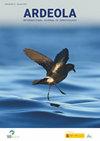在每年的监测计划中,每年春季两次调查足以获得常见和广泛分布的鸟类的种群趋势
IF 1.2
4区 生物学
Q2 ORNITHOLOGY
引用次数: 0
摘要
总结。广泛的鸟类监测计划是利用数千名观察员通过标准化实地调查提供的数据估计年际种群趋势的基础。Gordo(2018)提出,由于常见鸟类监测计划(例如SACRE计划)记录的丰度数据可能不准确,因此应谨慎使用,因为每年春季两次调查不足以记录采样地点单个鸟类的实际最大数量。我们进行了数值模拟,并分析了西班牙常见鸟类普查(SACRE方案)公布的种群趋势的种间统计显著性模式(1998-2011年),以测试每年重复普查的次数如何影响测试的能力(即发现事实上是真实的重要趋势的概率),以及获得低错误发现率的概率:即,在估计年度人口变化时,识别出实际上是错误的重大变化。我们同意Gordo(2018)的观点,即每年对同一采样站进行两次调查无法检测到整个繁殖季节鸟类的最大数量。然而,监测方案的目标不是在很长一段时间内获得每个取样单位的最大鸟类数量,而是衡量可靠的种群趋势。研究结果表明,对于数量丰富且分布广泛的鸟类(常见鸟类监测方案的重点类群),每季度两次调查记录的平均鸟类数量可以高度可靠地反映种群趋势,特别是长期平均趋势的年变化>±2.5%。非常稀有物种的实际种群趋势,如每次普查和UTM细胞的数据少于50个UTM平方和< 5只鸟,很难检测到,除非它们显示出每年的种群变化百分比大于±5%。——carrascal, L.M. & del Moral, J.C.(2021)。每年春季两次调查足以在年度监测计划中获得常见和广泛分布的鸟类的强劲种群趋势。农业学报,68:33-51。本文章由计算机程序翻译,如有差异,请以英文原文为准。
Two Surveys Per Spring Are Enough to Obtain Robust Population Trends of Common and Widespread Birds in Yearly Monitoring Programmes
Summary. Extensive bird monitoring programmes are fundamental for estimating inter-annual population trends using data provided by thousands of observers through standardised fieldwork. Gordo (2018) has proposed that abundance data recorded by common bird monitoring schemes (e.g. SACRE programme) should be used cautiously due to its potential inaccuracy, because two surveys per spring are not enough to record the actual maximum number of individual birds at a sampling location. We carried out numerical simulations and analysed the interspecific pattern of statistical significance of the published population trends of the Spanish common birds census, the SACRE programme (1998-2011), in order to test how the number of repetitions of censuses per year affects the power of tests: (i.e. the probability of detecting significant trends that are in fact true), and the probability of obtaining low false discovery rates: i.e. identifying significant changes that are actually false, when estimating yearly population changes. We agree with Gordo (2018) that two surveys of the same sampling stations per year are unable to detect the maximum number of birds throughout a breeding season. Nevertheless, the goal of monitoring programmes is not to obtain the maximum number of birds at each sampling unit over a long time span but to measure reliable population trends. Our results demonstrate that the average number of birds recorded in two surveys per season provides a highly reliable indication of population trends for abundant and widely distributed bird species, the focal taxa in common birds monitoring schemes, especially of long-term average trends > ±2.5% change annually. The actual population trends for very rare species, such as those with data from fewer than 50 UTM squares and < 5 individual birds per census and UTM cell, are hard to detect unless they show yearly percentage population changes greater than ±5%.—Carrascal, L.M. & del Moral, J.C. (2021). Two surveys per spring are enough to obtain robust population trends of common and widespread birds in yearly monitoring programmes. Ardeola, 68: 33-51.
求助全文
通过发布文献求助,成功后即可免费获取论文全文。
去求助
来源期刊
CiteScore
2.30
自引率
6.20%
发文量
16
审稿时长
>12 weeks
期刊介绍:
Ardeola: International Journal of Ornithology is the scientific journal of SEO/BirdLife, the Spanish Ornithological Society. The journal had a regional focus when it was first published, in 1954. Since then, and particular during the past two decades, the journal has expanded its thematic and geographical scope. It is now a fully international forum for research on all aspects of ornithology. We thus welcome studies within the fields of basic biology, ecology, behaviour, conservation and biogeography, especially those arising from hypothesis-based research. Although we have a long publication history of Mediterranean and Neotropical studies, we accept papers on investigations worldwide.
Each volume of Ardeola has two parts, published annually in January and July. The main body of each issue comprises full-length original articles (Papersand Review articles) and shorter notes on methodology or stimulating findings (Short Communications). The publication language is English, with summaries, figure legends and table captions also in Spanish. Ardeolaalso publishes critical Book Reviewsand PhD-Dissertation Summaries; summarising ornithological theses defended in Spain. Finally there are two Spanish-language sections, Ornithological News; summarising significant recent observations of birds in Spain, and Observations of Rare Birds in Spain, the annual reports of the Spanish Rarities Committee.

 求助内容:
求助内容: 应助结果提醒方式:
应助结果提醒方式:


